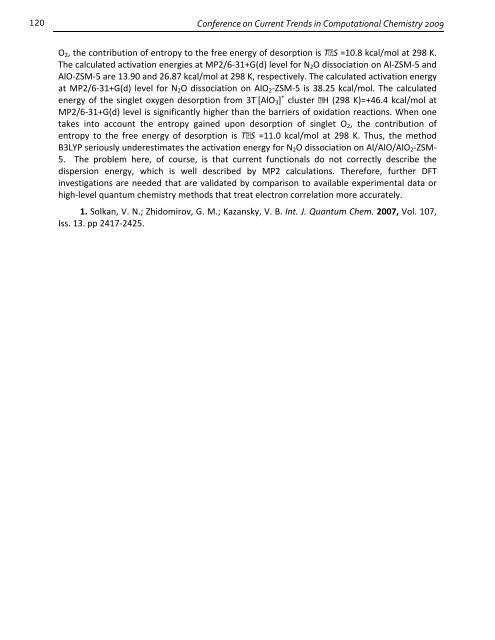Proceedings - Interdisciplinary Center for Nanotoxicity
Proceedings - Interdisciplinary Center for Nanotoxicity
Proceedings - Interdisciplinary Center for Nanotoxicity
Create successful ePaper yourself
Turn your PDF publications into a flip-book with our unique Google optimized e-Paper software.
120<br />
Conference on Current Trends in Computational Chemistry 2009<br />
O2, the contribution of entropy to the free energy of desorption is T S =10.8 kcal/mol at 298 K.<br />
The calculated activation energies at MP2/6‐31+G(d) level <strong>for</strong> N2O dissociation on Al‐ZSM‐5 and<br />
AlO‐ZSM‐5 are 13.90 and 26.87 kcal/mol at 298 K, respectively. The calculated activation energy<br />
at MP2/6‐31+G(d) level <strong>for</strong> N2O dissociation on AlO2‐ZSM‐5 is 38.25 kcal/mol. The calculated<br />
energy of the singlet oxygen desorption from 3T ‐ [AlO3] + cluster H (298 K)=+46.4 kcal/mol at<br />
MP2/6‐31+G(d) level is significantly higher than the barriers of oxidation reactions. When one<br />
takes into account the entropy gained upon desorption of singlet O2, the contribution of<br />
entropy to the free energy of desorption is T S =11.0 kcal/mol at 298 K. Thus, the method<br />
B3LYP seriously underestimates the activation energy <strong>for</strong> N2O dissociation on Al/AlO/AlO2‐ZSM‐<br />
5. The problem here, of course, is that current functionals do not correctly describe the<br />
dispersion energy, which is well described by MP2 calculations. There<strong>for</strong>e, further DFT<br />
investigations are needed that are validated by comparison to available experimental data or<br />
high‐level quantum chemistry methods that treat electron correlation more accurately.<br />
1. Solkan, V. N.; Zhidomirov, G. M.; Kazansky, V. B. Int. J. Quantum Chem. 2007, Vol. 107,<br />
Iss. 13. pp 2417‐2425.



